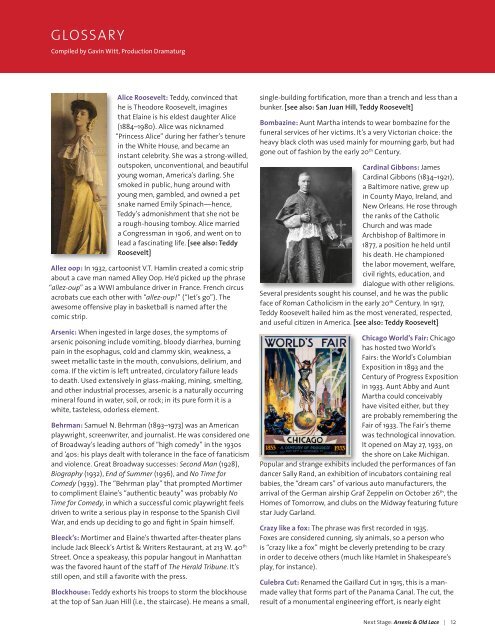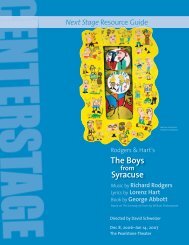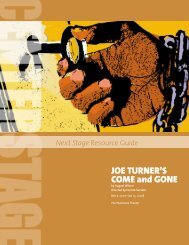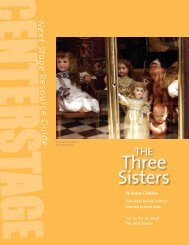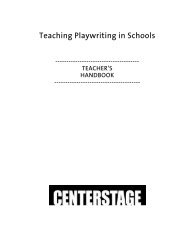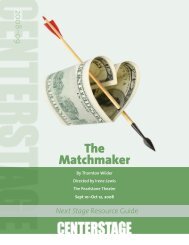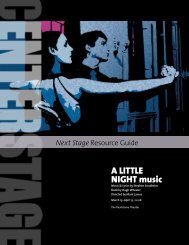Arsenic & Old lAce - Center Stage
Arsenic & Old lAce - Center Stage
Arsenic & Old lAce - Center Stage
You also want an ePaper? Increase the reach of your titles
YUMPU automatically turns print PDFs into web optimized ePapers that Google loves.
Glossary<br />
Compiled by Gavin Witt, Production Dramaturg<br />
Alice Roosevelt: Teddy, convinced that<br />
he is Theodore Roosevelt, imagines<br />
that Elaine is his eldest daughter Alice<br />
(1884–1980). Alice was nicknamed<br />
“Princess Alice” during her father’s tenure<br />
in the White House, and became an<br />
instant celebrity. She was a strong-willed,<br />
outspoken, unconventional, and beautiful<br />
young woman, America’s darling. She<br />
smoked in public, hung around with<br />
young men, gambled, and owned a pet<br />
snake named Emily Spinach—hence,<br />
Teddy’s admonishment that she not be<br />
a rough-housing tomboy. Alice married<br />
a Congressman in 1906, and went on to<br />
lead a fascinating life. [see also: Teddy<br />
Roosevelt]<br />
Allez oop: In 1932, cartoonist V.T. Hamlin created a comic strip<br />
about a cave man named Alley Oop. He’d picked up the phrase<br />
“allez-oup” as a WWI ambulance driver in France. French circus<br />
acrobats cue each other with “allez-oup!” (“let’s go”). The<br />
awesome offensive play in basketball is named after the<br />
comic strip.<br />
<strong>Arsenic</strong>: When ingested in large doses, the symptoms of<br />
arsenic poisoning include vomiting, bloody diarrhea, burning<br />
pain in the esophagus, cold and clammy skin, weakness, a<br />
sweet metallic taste in the mouth, convulsions, delirium, and<br />
coma. If the victim is left untreated, circulatory failure leads<br />
to death. Used extensively in glass-making, mining, smelting,<br />
and other industrial processes, arsenic is a naturally occurring<br />
mineral found in water, soil, or rock; in its pure form it is a<br />
white, tasteless, odorless element.<br />
Behrman: Samuel N. Behrman (1893–1973) was an American<br />
playwright, screenwriter, and journalist. He was considered one<br />
of Broadway’s leading authors of “high comedy” in the 1930s<br />
and ‘40s: his plays dealt with tolerance in the face of fanaticism<br />
and violence. Great Broadway successes: Second Man (1928),<br />
Biography (1932), End of Summer (1936), and No Time for<br />
Comedy (1939). The “Behrman play” that prompted Mortimer<br />
to compliment Elaine’s “authentic beauty” was probably No<br />
Time for Comedy, in which a successful comic playwright feels<br />
driven to write a serious play in response to the Spanish Civil<br />
War, and ends up deciding to go and fight in Spain himself.<br />
Bleeck’s: Mortimer and Elaine’s thwarted after-theater plans<br />
include Jack Bleeck’s Artist & Writers Restaurant, at 213 W. 40 th<br />
Street. Once a speakeasy, this popular hangout in Manhattan<br />
was the favored haunt of the staff of The Herald Tribune. It’s<br />
still open, and still a favorite with the press.<br />
Blockhouse: Teddy exhorts his troops to storm the blockhouse<br />
at the top of San Juan Hill (i.e., the staircase). He means a small,<br />
single-building fortification, more than a trench and less than a<br />
bunker. [see also: San Juan Hill, Teddy Roosevelt]<br />
Bombazine: Aunt Martha intends to wear bombazine for the<br />
funeral services of her victims. It’s a very Victorian choice: the<br />
heavy black cloth was used mainly for mourning garb, but had<br />
gone out of fashion by the early 20 th Century.<br />
Cardinal Gibbons: James<br />
Cardinal Gibbons (1834–1921),<br />
a Baltimore native, grew up<br />
in County Mayo, Ireland, and<br />
New Orleans. He rose through<br />
the ranks of the Catholic<br />
Church and was made<br />
Archbishop of Baltimore in<br />
1877, a position he held until<br />
his death. He championed<br />
the labor movement, welfare,<br />
civil rights, education, and<br />
dialogue with other religions.<br />
Several presidents sought his counsel, and he was the public<br />
face of Roman Catholicism in the early 20 th Century. In 1917,<br />
Teddy Roosevelt hailed him as the most venerated, respected,<br />
and useful citizen in America. [see also: Teddy Roosevelt]<br />
Chicago World’s Fair: Chicago<br />
has hosted two World’s<br />
Fairs: the World’s Columbian<br />
Exposition in 1893 and the<br />
Century of Progress Exposition<br />
in 1933. Aunt Abby and Aunt<br />
Martha could conceivably<br />
have visited either, but they<br />
are probably remembering the<br />
Fair of 1933. The Fair’s theme<br />
was technological innovation.<br />
It opened on May 27, 1933, on<br />
the shore on Lake Michigan.<br />
Popular and strange exhibits included the performances of fan<br />
dancer Sally Rand, an exhibition of incubators containing real<br />
babies, the “dream cars” of various auto manufacturers, the<br />
arrival of the German airship Graf Zeppelin on October 26 th , the<br />
Homes of Tomorrow, and clubs on the Midway featuring future<br />
star Judy Garland.<br />
Crazy like a fox: The phrase was first recorded in 1935.<br />
Foxes are considered cunning, sly animals, so a person who<br />
is “crazy like a fox” might be cleverly pretending to be crazy<br />
in order to deceive others (much like Hamlet in Shakespeare’s<br />
play, for instance).<br />
Culebra Cut: Renamed the Gaillard Cut in 1915, this is a manmade<br />
valley that forms part of the Panama Canal. The cut, the<br />
result of a monumental engineering effort, is nearly eight<br />
Next <strong>Stage</strong>: <strong>Arsenic</strong> & <strong>Old</strong> Lace | 12


